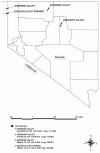Nonmarine crenarchaeol in Nevada hot springs
- PMID: 15345404
- PMCID: PMC520871
- DOI: 10.1128/AEM.70.9.5229-5237.2004
Nonmarine crenarchaeol in Nevada hot springs
Abstract
Glycerol dialkyl glycerol tetraethers (GDGTs) are core membrane lipids of the Crenarchaeota. The structurally unusual GDGT crenarchaeol has been proposed as a taxonomically specific biomarker for the marine planktonic group I archaea. It is found ubiquitously in the marine water column and in sediments. In this work, samples of microbial community biomass were obtained from several alkaline and neutral-pH hot springs in Nevada, United States. Lipid extracts of these samples were analyzed by high-performance liquid chromatography-mass spectrometry and by gas chromatography-mass spectrometry. Each sample contained GDGTs, and among these compounds was crenarchaeol. The distribution of archaeal lipids in Nevada hot springs did not appear to correlate with temperature, as has been observed in the marine environment. Instead, a significant correlation with the concentration of bicarbonate was observed. Archaeal DNA was analyzed by denaturing gradient gel electrophoresis. All samples contained 16S rRNA gene sequences which were more strongly related to thermophilic crenarchaeota than to Cenarchaeum symbiosum, a marine nonthermophilic crenarchaeon. The occurrence of crenarchaeol in environments containing sequences affiliated with thermophilic crenarchaeota suggests a wide phenotypic distribution of this compound. The results also indicate that crenarchaeol can no longer be considered an exclusive biomarker for marine species.
Figures






Similar articles
-
In situ production of crenarchaeol in two california hot springs.Appl Environ Microbiol. 2009 Jul;75(13):4443-51. doi: 10.1128/AEM.02591-08. Epub 2009 May 1. Appl Environ Microbiol. 2009. PMID: 19411420 Free PMC article.
-
Archaeal and bacterial glycerol dialkyl glycerol tetraether lipids in hot springs of yellowstone national park.Appl Environ Microbiol. 2007 Oct;73(19):6181-91. doi: 10.1128/AEM.00630-07. Epub 2007 Aug 10. Appl Environ Microbiol. 2007. PMID: 17693566 Free PMC article.
-
Factors controlling the distribution of archaeal tetraethers in terrestrial hot springs.Appl Environ Microbiol. 2008 Jun;74(11):3523-32. doi: 10.1128/AEM.02450-07. Epub 2008 Apr 4. Appl Environ Microbiol. 2008. PMID: 18390673 Free PMC article.
-
Distribution of ether lipids and composition of the archaeal community in terrestrial geothermal springs: impact of environmental variables.Environ Microbiol. 2015 May;17(5):1600-14. doi: 10.1111/1462-2920.12595. Epub 2014 Oct 13. Environ Microbiol. 2015. PMID: 25142282
-
The lipids of archaebacteria.Prog Lipid Res. 1988;27(3):153-75. doi: 10.1016/0163-7827(88)90011-2. Prog Lipid Res. 1988. PMID: 3151021 Review. No abstract available.
Cited by
-
Pathways of carbon assimilation and ammonia oxidation suggested by environmental genomic analyses of marine Crenarchaeota.PLoS Biol. 2006 Apr;4(4):e95. doi: 10.1371/journal.pbio.0040095. Epub 2006 Mar 21. PLoS Biol. 2006. PMID: 16533068 Free PMC article.
-
Planktonic Euryarchaeota are a significant source of archaeal tetraether lipids in the ocean.Proc Natl Acad Sci U S A. 2014 Jul 8;111(27):9858-63. doi: 10.1073/pnas.1409439111. Epub 2014 Jun 19. Proc Natl Acad Sci U S A. 2014. PMID: 24946804 Free PMC article.
-
Microbiology and geochemistry of great boiling and mud hot springs in the United States Great Basin.Extremophiles. 2009 May;13(3):447-59. doi: 10.1007/s00792-009-0230-x. Epub 2009 Feb 27. Extremophiles. 2009. PMID: 19247786
-
Enrichment and genome sequence of the group I.1a ammonia-oxidizing Archaeon "Ca. Nitrosotenuis uzonensis" representing a clade globally distributed in thermal habitats.PLoS One. 2013 Nov 20;8(11):e80835. doi: 10.1371/journal.pone.0080835. eCollection 2013. PLoS One. 2013. PMID: 24278328 Free PMC article.
-
In situ production of crenarchaeol in two california hot springs.Appl Environ Microbiol. 2009 Jul;75(13):4443-51. doi: 10.1128/AEM.02591-08. Epub 2009 May 1. Appl Environ Microbiol. 2009. PMID: 19411420 Free PMC article.
References
-
- CalCOFI Database. 1996. CalCOFI cruise 9610, SIO reference series, University of California. Scripps Institution of Oceanography, San Diego, Calif.
-
- Chelius, M. K., and E. W. Triplett. 2001. The diversity of Archaea and Bacteria in association with the roots of Zea mays L. Microbiol. Ecol. 41:252-263. - PubMed
Publication types
MeSH terms
Substances
Associated data
- Actions
- Actions
- Actions
- Actions
- Actions
- Actions
- Actions
- Actions
LinkOut - more resources
Full Text Sources

